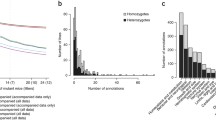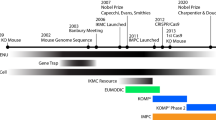Abstract
The International Knockout Mouse Consortium (IKMC; http://www.mousephenotype.org) has generated mutations in almost every protein-coding mouse gene and is completing the companion Cre driver resource to expand tissue-specific conditional mutagenesis. Accordingly, the IKMC has carried out high-throughput gene trapping and targeting producing conditional mutations in murine embryonic stem cells in more than 18,500 genes, from which at least 4900 mutant mouse lines have been established to date. This resource is currently being upgraded with more powerful tools, such as visualization and manipulation cassettes that can be easily introduced into IKMC alleles for multifaceted functional studies. In addition, we discuss how existing IKMC products can be used in combination with CRISPR technology to accelerate genome engineering projects. All information and materials from this extraordinary biological resource together with coordinated phenotyping efforts can be retrieved at www.mousephenotype.org. The comprehensive IKMC knockout resource in combination with an extensive set of modular gene cassettes will continue to enhance functional gene annotation in the future and solidify its impact on biomedical research.



Similar content being viewed by others
References
Austin CP, Battey JF et al (2004) The knockout mouse project. Nat Genet 36:921–924
Auwerx J, Avner P et al (2004) The European dimension for the mouse genome mutagenesis program. Nat Genet 36:925–927
Bradley A, Anastassiadis K et al (2012) The mammalian gene function resource: the International Knockout Mouse Consortium. Mamm Genome 23:580–586
Capecchi MR (1989) The new mouse genetics: altering the genome by gene targeting. Trends Genet 5:70–76
Collins FS, Rossant J et al (2007a) A mouse for all reasons. Cell 128:9–13
Collins FS, Finnell RH et al (2007b) A new partner for the international knockout mouse consortium. Cell 129:235
de Felipe P, Luke GA et al (2010) Inhibition of 2A-mediated ‘cleavage’ of certain artificial polyproteins bearing N-terminal signal sequences. Biotechnol J 5:213–223
de Angelis MH, Nicholson G (2015) Analysis of mammalian gene function through broad-based phenotypic screens across a consortium of mouse clinics. Nat Genet. doi:10.1038/ng.3360
Friedrich G, Soriano P (1991) Promoter traps in embryonic stem cells: a genetic screen to identify and mutate developmental genes in mice. Genes Dev 5:1513–1523
Fu J, Bian X et al (2012) Full-length RecE enhances linear-linear homologous recombination and facilitates direct cloning for bioprospecting. Nat Biotechnol 30:440–446
Gossler A, Joyner AL et al (1989) Mouse embryonic stem cells and reporter constructs to detect developmentally regulated genes. Science 244:463–465
Horn C, Hansen J et al (2007) Splinkerette PCR for more efficient characterization of gene trap events. Nat Genet 39:933–934
Jinek M, Chylinski K et al (2012) A programmable dual-RNA-guided DNA endonuclease in adaptive bacterial immunity. Science 337:816–821
Kranz A, Fu J et al (2010) An improved Flp deleter mouse in C57Bl/6 based on Flpo recombinase. Genesis 48(8):512–520
Mendjan S, Mascetti VL et al (2014) NANOG and CDX2 pattern distinct subtypes of human mesoderm during exit from pluripotency. Cell Stem Cell 15:310–325
Nord AS, Vranizan K et al (2007) Modeling insertional mutagenesis using gene length and expression in murine embryonic stem cells. PLoS One 2:e617
Osterwalder M, Galli A et al (2010) Dual RMCE for efficient re-engineering of mouse mutant alleles. Nat Methods 7:893–895
Patsch C, Kesseler D et al (2011) Genetic engineering of mammalian cells by direct delivery of FLP recombinase protein. Methods 53(4):386–393
Pettitt SJ, Liang Q et al (2009) Agouti C57BL/6N embryonic stem cells for mouse genetic resources. Nat Methods 6:493–495
Ringwald M, Iyer V et al (2011) The IKMC web portal: a central point of entry to data and resources from the International Knockout Mouse Consortium. Nucleic Acids Res 39:D849–D855
Ryder E, Doe B et al (2014) Rapid conversion of EUCOMM/KOMP-CSD alleles in mouse embryos using a cell-permeable Cre recombinase. Transgenic Res 23(1):177–185
Schebelle L, Wolf C et al (2010) Efficient conditional and promoter-specific in vivo expression of cDNAs of choice by taking advantage of recombinase-mediated cassette exchange using FlEx gene traps. Nucleic Acids Res 38:e106
Schnutgen F, De-Zolt S et al (2005) Genomewide production of multipurpose alleles for the functional analysis of the mouse genome. Proc Natl Acad Sci USA 102:7221–7226
Skarnes WC, von Melchner H et al (2004) A public gene trap resource for mouse functional genomics. Nat Genet 36:543–544
Skarnes WC, Rosen B et al (2011) A conditional knockout resource for the genome-wide study of mouse gene function. Nature 474:337–342
Stribl C, Samara A et al (2014) Mitochondrial dysfunction and decrease in body weight of a transgenic knockin mouse model for TDP-43. J Biol Chem 289:10769–10784
Testa G, Schaft J et al (2004) A reliable lacZ expression reporter cassette for multipurpose, knockout-first alleles. Genesis 38:151–158
Townley DJ, Avery BJ et al (1997) Rapid sequence analysis of gene trap integrations to generate a resource of insertional mutations in mice. Genome Res 7:293–298
Valenzuela DM, Murphy AJ et al (2003) High-throughput engineering of the mouse genome coupled with high-resolution expression analysis. Nat Biotechnol 21:652–659
White JK, Gerdin AK et al (2013) Genome-wide generation and systematic phenotyping of knockout mice reveals new roles for many genes. Cell 154(2):452–464
Wiles MV, Vauti F et al (2000) Establishment of a gene-trap sequence tag library to generate mutant mice from embryonic stem cells. Nat Genet 24:13–14
Wurst W, Rossant J et al (1995) A large-scale gene-trap screen for insertional mutations in developmentally regulated genes in mice. Genetics 139:889–899
Acknowledgement
The authors thank all members of EUCOMM/EUCOMMTOOLS, IKMC, EUMODIC, and the IMPC for their dedicated hard work and constant support in establishing this comprehensive resource. We in particular thank Vivek Iyer, Joachim Beig, and Jens Hansen for bioinformatics data analysis and Cornelia Kaloff, Laura Schwabe, and Derek Matthews for coordination support. The authors are supported by EUCOMM and EUCOMMTOOLS projects which are funded by the European Commission [LSHG-CT-2005-018931 and FP7-HEALTH-F4-2010-261492].
Author information
Authors and Affiliations
Corresponding author
Ethics declarations
Conflict of interest
The authors have no conflict of interest to declare.
Rights and permissions
About this article
Cite this article
Rosen, B., Schick, J. & Wurst, W. Beyond knockouts: the International Knockout Mouse Consortium delivers modular and evolving tools for investigating mammalian genes. Mamm Genome 26, 456–466 (2015). https://doi.org/10.1007/s00335-015-9598-3
Received:
Accepted:
Published:
Issue Date:
DOI: https://doi.org/10.1007/s00335-015-9598-3




